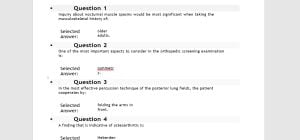COURSE
NURS 6512 Advanced Health Assessment and Diagnostic
Number of Questions: 1 -101
Questions
- Question: The reliability of health-related findings and observations is the responsibility of the:
- Question: Inquiry about nocturnal muscle spasms would be most significant when taking the musculoskeletal history of:
- Question: As Mr. B. enters the room, you observe that his gait is wide based and he staggers from side to side while swaying his trunk. You would document Mr. B.’s pattern as:
- Question: When palpating joints, crepitus may occur when:
- Question: A grade IV mitral regurgitation murmur would:
- Question: Electrical activity recorded by the electrocardiogram (ECG) tracing that denotes the spread of the stimulus through the atria is the:
- Question: Temporalis and masseter muscles are evaluated by:
- Question: When assessing superficial pain, touch, vibration, and position perceptions, you are testing:
- Question: To hear diastolic heart sounds, you should ask patients to:
- Question: A finding that is indicative of osteoarthritis is:
- Question: For purposes of examination and communication of physical findings, the breast is divided into:
- Question: Diabetic peripheral neuropathy will likely produce:
- Question: You are conducting a preparticipation physical examination for a 10-year-old girl with Down syndrome who will be playing basketball. She has slight torticollis and mild ankle clonus. What additional diagnostic testing would be required for her?
- Question: Recent unilateral inversion of a previously everted nipple suggests:
- Question: One of the most important aspects to consider in the orthopedic screening examination is:
- Question: Your older clinic patient is being seen today as a follow-up for a 2-day history of pneumonia. The patient continues to have a productive cough, shortness of breath, and lethargy and has been spending most of the day lying in bed. You should begin the chest examination by:
- Question: An apical PMI palpated beyond the left fifth intercostal space may indicate:
- Question: Ulnar deviation and boutonniere deformities are characteristic of:
- Question: In the most effective percussion technique of the posterior lung fields, the patient cooperates by:
- Question: When assessing a 17-year-old for nuchal rigidity, you gently raise his head off the examination table. He involuntarily flexes his hips and knees. To confirm your suspicions associated with this positive test, you would also perform a test for the _____ sign.
- Question: You are initially evaluating the equilibrium of Ms. Q. You ask her to stand with her feet together and arms at her sides. She loses her balance. Ms. Q. has a positive:
- Question: Anterior cruciate ligament integrity is assessed via the _____ test.
- Question: The presence of cervical motion tenderness may indicate:
- Question: While collecting personal and social history data from a woman complaining of breast discomfort, you should question her regarding:
- Question: Assessing orientation to person, place, and time helps determine:
- Question: You are examining Mr. S., a 79-year-old diabetic man complaining of claudication. Which of the following physical findings is consistent with the diagnosis of arterial occlusion?
- Question: Your 15-year-old patient is athletic and thin. Radiography of an ankle injury reveals a stress fracture. You should question this patient about her:
- Question: To spread the breast tissue evenly over the chest wall, you should ask the woman to lie supine with:………
ANSWERS

……..please click the icon below to purchase full final exam answers at $35